
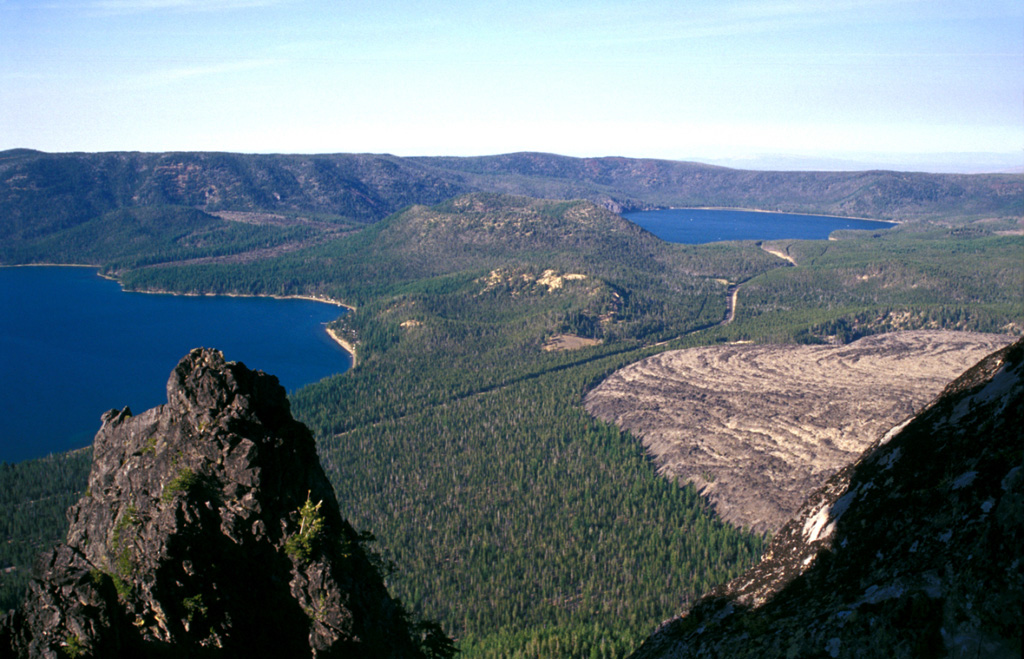
The Global Volcanism Program has no activity reports available for Newberry.
The Global Volcanism Program has no Weekly Reports available for Newberry.
The Global Volcanism Program has no Bulletin Reports available for Newberry.
|
|
||||||||||||||||||||||||||
There is data available for 11 confirmed eruptive periods.
0690 ± 100 years Confirmed Eruption (Explosive / Effusive) VEI: 4
| Episode 1 | Eruption (Explosive / Effusive) | S caldera wall, Big Obsidian Flow | ||||||||||||||||||||||||||||||||||||||
|---|---|---|---|---|---|---|---|---|---|---|---|---|---|---|---|---|---|---|---|---|---|---|---|---|---|---|---|---|---|---|---|---|---|---|---|---|---|---|---|
| 0690 ± 100 years - Unknown | Evidence from Isotopic: 14C (calibrated) | ||||||||||||||||||||||||||||||||||||||
|
List of 6 Events for Episode 1 at S caldera wall, Big Obsidian Flow
|
|||||||||||||||||||||||||||||||||||||||
0490 ± 100 years Confirmed Eruption (Explosive / Effusive) VEI: 4
| Episode 1 | Eruption (Explosive / Effusive) | South caldera wall | ||||||||||||||||||||||||||||
|---|---|---|---|---|---|---|---|---|---|---|---|---|---|---|---|---|---|---|---|---|---|---|---|---|---|---|---|---|---|
| 0490 ± 100 years - Unknown | Evidence from Isotopic: 14C (calibrated) | ||||||||||||||||||||||||||||
|
List of 4 Events for Episode 1 at South caldera wall
|
|||||||||||||||||||||||||||||
1450 BCE (?) Confirmed Eruption (Explosive / Effusive)
| Episode 1 | Eruption (Explosive / Effusive) | South of East Lake | ||||||||||||||||||||||||||||
|---|---|---|---|---|---|---|---|---|---|---|---|---|---|---|---|---|---|---|---|---|---|---|---|---|---|---|---|---|---|
| 1450 BCE (?) - Unknown | Evidence from Chem/Bio: Hydration Rind | ||||||||||||||||||||||||||||
|
List of 4 Events for Episode 1 at South of East Lake
|
|||||||||||||||||||||||||||||
4450 BCE (?) Confirmed Eruption (Explosive / Effusive)
| Episode 1 | Eruption (Explosive / Effusive) | Center, N & S caldera, upper SE flank, Central Pumice Cone, Game Hut Obsidian | ||||||||||||||||||||||||||||
|---|---|---|---|---|---|---|---|---|---|---|---|---|---|---|---|---|---|---|---|---|---|---|---|---|---|---|---|---|---|
| 4450 BCE (?) - Unknown | Evidence from Chem/Bio: Hydration Rind | ||||||||||||||||||||||||||||
|
List of 4 Events for Episode 1 at Center, N & S caldera, upper SE flank, Central Pumice Cone, Game Hut Obsidian
|
|||||||||||||||||||||||||||||
4690 BCE ± 150 years Confirmed Eruption (Explosive / Effusive) VEI: 0
| Episode 1 | Eruption (Explosive / Effusive) | NW rift zone, Lava Cascade flow | ||||||||||||||||||
|---|---|---|---|---|---|---|---|---|---|---|---|---|---|---|---|---|---|---|---|
| 4690 BCE ± 150 years - Unknown | Evidence from Isotopic: 14C (calibrated) | ||||||||||||||||||
|
List of 2 Events for Episode 1 at NW rift zone, Lava Cascade flow
|
|||||||||||||||||||
4770 BCE ± 75 years Confirmed Eruption (Explosive / Effusive)
| Episode 1 | Eruption (Explosive / Effusive) | NW rift zone (Sugarpine Butte) | ||||||||||||||||||||||||||||
|---|---|---|---|---|---|---|---|---|---|---|---|---|---|---|---|---|---|---|---|---|---|---|---|---|---|---|---|---|---|
| 4770 BCE ± 75 years - Unknown | Evidence from Isotopic: 14C (calibrated) | ||||||||||||||||||||||||||||
|
List of 4 Events for Episode 1 at NW rift zone (Sugarpine Butte)
|
|||||||||||||||||||||||||||||
4860 BCE ± 150 years Confirmed Eruption (Explosive / Effusive) VEI: 0
| Episode 1 | Eruption (Explosive / Effusive) | NW rift zone, Forest Road flow | ||||||||||||||||||
|---|---|---|---|---|---|---|---|---|---|---|---|---|---|---|---|---|---|---|---|
| 4860 BCE ± 150 years - Unknown | Evidence from Isotopic: 14C (calibrated) | ||||||||||||||||||
|
List of 2 Events for Episode 1 at NW rift zone, Forest Road flow
|
|||||||||||||||||||
4960 BCE ± 100 years Confirmed Eruption (Explosive / Effusive)
| Episode 1 | Eruption (Explosive / Effusive) | East Lake fissure, south flank | ||||||||||||||||||
|---|---|---|---|---|---|---|---|---|---|---|---|---|---|---|---|---|---|---|---|
| 4960 BCE ± 100 years - Unknown | Evidence from Isotopic: 14C (calibrated) | ||||||||||||||||||
|
List of 2 Events for Episode 1 at East Lake fissure, south flank
|
|||||||||||||||||||
5070 BCE ± 150 years Confirmed Eruption (Explosive / Effusive) VEI: 3
| Episode 1 | Eruption (Explosive / Effusive) | Lower NW rift zone (Lava Butte) | |||||||||||||||||||||||||||||||||
|---|---|---|---|---|---|---|---|---|---|---|---|---|---|---|---|---|---|---|---|---|---|---|---|---|---|---|---|---|---|---|---|---|---|---|
| 5070 BCE ± 150 years - Unknown | Evidence from Isotopic: 14C (calibrated) | |||||||||||||||||||||||||||||||||
|
List of 5 Events for Episode 1 at Lower NW rift zone (Lava Butte)
|
||||||||||||||||||||||||||||||||||
5260 BCE ± 150 years Confirmed Eruption (Explosive / Effusive) VEI: 0
| Episode 1 | Eruption (Explosive / Effusive) | NW rift zone (Lava Cast Forest) | ||||||||||||||||||
|---|---|---|---|---|---|---|---|---|---|---|---|---|---|---|---|---|---|---|---|
| 5260 BCE ± 150 years - Unknown | Evidence from Isotopic: 14C (calibrated) | ||||||||||||||||||
|
List of 2 Events for Episode 1 at NW rift zone (Lava Cast Forest)
|
|||||||||||||||||||
9210 BCE ± 1200 years Confirmed Eruption (Explosive / Effusive)
| Episode 1 | Eruption (Explosive / Effusive) | South and east caldera rim | |||||||||||||||||||||||||||||||||
|---|---|---|---|---|---|---|---|---|---|---|---|---|---|---|---|---|---|---|---|---|---|---|---|---|---|---|---|---|---|---|---|---|---|---|
| 9210 BCE ± 1200 years - Unknown | Evidence from Isotopic: 14C (calibrated) | |||||||||||||||||||||||||||||||||
|
List of 5 Events for Episode 1 at South and east caldera rim
|
||||||||||||||||||||||||||||||||||
This compilation of synonyms and subsidiary features may not be comprehensive. Features are organized into four major categories: Cones, Craters, Domes, and Thermal Features. Synonyms of features appear indented below the primary name. In some cases additional feature type, elevation, or location details are provided.
Cones |
||||
| Feature Name | Feature Type | Elevation | Latitude | Longitude |
| Bessie Butte | Cone | 1453 m | 43° 57' 0.00" N | 121° 16' 0.00" W |
| Big Obsidian Flow | Vent | 43° 41' 0.00" N | 121° 14' 0.00" W | |
| Central Pumice Cone | Pyroclastic cone | 43° 43' 0.00" N | 121° 14' 0.00" W | |
| Cinder Hill | Cone | 1966 m | 43° 45' 0.00" N | 121° 9' 0.00" W |
| Company Butte | Cone | 1845 m | 43° 48' 0.00" N | 121° 9' 0.00" W |
| Crater Buttes | Cone | 43° 34' 0.00" N | 121° 14' 0.00" W | |
| Dome, The | Pyroclastic cone | 2101 m | 43° 42' 0.00" N | 121° 11' 0.00" W |
| Finley Butte | Cone | 1458 m | 43° 39' 0.00" N | 121° 26' 0.00" W |
| Firestone Butte | Cone | 43° 39' 0.00" N | 120° 58' 0.00" W | |
| Fuzztail Butte | Cone | 1751 m | 43° 51' 57.00" N | 121° 12' 33.00" W |
| Green Butte | Cone | 1757 m | 43° 35' 0.00" N | 121° 19' 0.00" W |
| Horse Butte | Cone | 43° 59' 0.00" N | 121° 14' 0.00" W | |
| Indian Butte | Cone | 1825 m | 43° 33' 0.00" N | 121° 9' 0.00" W |
| Ipswoot Butte | Cone | 43° 33' 0.00" N | 121° 21' 0.00" W | |
| Kawak Butte | Cone | 2246 m | 43° 46' 0.00" N | 121° 16' 0.00" W |
| Kelly Butte | Cone | 43° 39' 0.00" N | 121° 1' 0.00" W | |
| Klawhop Butte | Pyroclastic cone | 1680 m | 43° 53' 0.00" N | 121° 17' 0.00" W |
| Klone Butte | Pyroclastic cone | 1860 m | 43° 49' 0.00" N | 121° 17' 0.00" W |
| Kweo Butte | Cone | 43° 39' 0.00" N | 121° 12' 0.00" W | |
| Kwinnum Butte | Cone | 1965 m | 43° 48' 0.00" N | 121° 15' 0.00" W |
| Lava Butte | Pyroclastic cone | 1729 m | 43° 52' 27.00" N | 121° 12' 6.00" W |
| Lava Top Butte | Cone | 1662 m | 43° 52' 0.00" N | 121° 12' 0.00" W |
| Lockit Butte | Cone | 1873 m | 43° 50' 0.00" N | 121° 14' 0.00" W |
| Lowullo Butte | Cone | 2060 m | 43° 47' 0.00" N | 121° 6' 0.00" W |
| Luna Butte | Cone | 1596 m | 43° 54' 7.00" N | 121° 29' 0.00" W |
| Mokst Butte | Pyroclastic cone | 1884 m | 43° 50' 0.00" N | 121° 17' 0.00" W |
| North Paulina Peak | Cone | 2402 m | 43° 45' 0.00" N | 121° 15' 0.00" W |
| Orphan Butte | Cone | 1766 m | 43° 48' 0.00" N | 121° 8' 0.00" W |
| Pilpil Butte | Cone | 2090 m | 43° 47' 0.00" N | 121° 14' 0.00" W |
| Polytop Butte | Cone | 43° 37' 0.00" N | 120° 59' 0.00" W | |
| Sand Butte | Cone | 43° 41' 0.00" N | 121° 11' 0.00" W | |
| Spring Butte | Cone | 1665 m | 43° 31' 0.00" N | 121° 21' 0.00" W |
| Sugarpine Butte | Pyroclastic cone | 1647 m | 43° 50' 0.00" N | 121° 21' 0.00" W |
| Swamp Wells Butte | Cone | 1796 m | 43° 51' 0.00" N | 121° 13' 0.00" W |
| Taghum Butte | Cone | 1875 m | 43° 49' 0.00" N | 121° 11' 0.00" W |
| Topso Butte | Cone | 43° 39' 0.00" N | 121° 11' 0.00" W | |
| Willow Butte | Cone | 43° 33' 0.00" N | 121° 10' 0.00" W | |
| Youtlkut Butte | Cone | 43° 36' 0.00" N | 121° 14' 0.00" W | |
Craters |
||||
| Feature Name | Feature Type | Elevation | Latitude | Longitude |
| East Lake Fissure | Fissure vent | 43° 44' 0.00" N | 121° 14' 0.00" W | |
| Northwest Rift Zone | Fissure vent | 43° 51' 0.00" N | 121° 18' 0.00" W | |
Domes |
||||
| Feature Name | Feature Type | Elevation | Latitude | Longitude |
| Indian Butte | Dome | 43° 32' 0.00" N | 121° 18' 0.00" W | |
| McKay Butte | Dome | 1601 m | 43° 43' 0.00" N | 121° 22' 0.00" W |
| Paulina Peak | Dome | 2434 m | 43° 41' 20.00" N | 121° 15' 14.00" W |
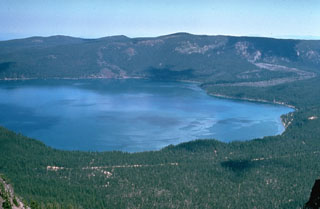 Paulina Lake is the westernmost of two lakes within Newberry caldera and is seen here from Paulina Peak, the high point of the southern caldera rim. The lava flow entering the lake to the upper right erupted about 6,400 years ago from the Central Pumice Cone. The flow split into two lobes, and the other lobe traveled into East Lake, just out of view to the right. This was one of several eruptive vents within the caldera that were active during this eruptive phase.
Paulina Lake is the westernmost of two lakes within Newberry caldera and is seen here from Paulina Peak, the high point of the southern caldera rim. The lava flow entering the lake to the upper right erupted about 6,400 years ago from the Central Pumice Cone. The flow split into two lobes, and the other lobe traveled into East Lake, just out of view to the right. This was one of several eruptive vents within the caldera that were active during this eruptive phase.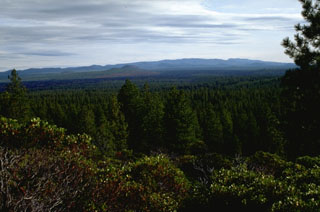 Newberry shield volcano covers an area of about 1,600 km2 about 60 km E of the crest of the Cascade Range in central Oregon. The low-angle shield volcano covers an area of 60 km in a N-S direction and 30 km E-W. More than 400 scoria cones dot the flanks of the volcano, including Lava Butte at the left center of this photo, one of many cones formed around 6,100 years ago along the NW rift zone.
Newberry shield volcano covers an area of about 1,600 km2 about 60 km E of the crest of the Cascade Range in central Oregon. The low-angle shield volcano covers an area of 60 km in a N-S direction and 30 km E-W. More than 400 scoria cones dot the flanks of the volcano, including Lava Butte at the left center of this photo, one of many cones formed around 6,100 years ago along the NW rift zone.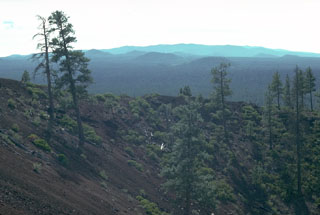 The crater rim of Lava Butte scoria cone on the NW flank provides a view of the broad Newberry shield volcano. Many other NW flank cones and associated lava flows erupted about the same time as the Lava Butte cone and lava flow. Over the past 7,700 years Newberry has erupted both mafic and silicic lavas from flank vents and within the caldera, respectively.
The crater rim of Lava Butte scoria cone on the NW flank provides a view of the broad Newberry shield volcano. Many other NW flank cones and associated lava flows erupted about the same time as the Lava Butte cone and lava flow. Over the past 7,700 years Newberry has erupted both mafic and silicic lavas from flank vents and within the caldera, respectively.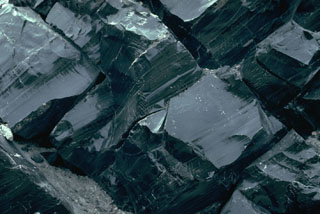 The Big Obsidian Flow erupted from Newberry caldera in central Oregon is composed of glassy rhyolite, formed when lava rapidly cools. The flow covers 20 km2 of the caldera floor. Obsidian flows are never entirely glassy, but also contain large amounts of frothy pumiceous material and devitrified (crystallized) spherulites, which commonly form bands alternating with layers of glass.
The Big Obsidian Flow erupted from Newberry caldera in central Oregon is composed of glassy rhyolite, formed when lava rapidly cools. The flow covers 20 km2 of the caldera floor. Obsidian flows are never entirely glassy, but also contain large amounts of frothy pumiceous material and devitrified (crystallized) spherulites, which commonly form bands alternating with layers of glass.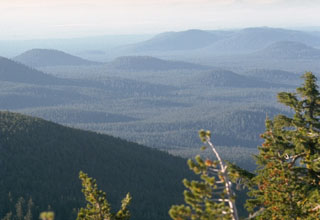 As many as 400 scoria cones that dot the flanks of the massive 30 x 60 km wide Newberry shield volcano in Oregon are seen in this view from Paulina Peak on the south rim of Newberry caldera. The scoria cones at Newberry are most abundant on the north and south flanks. Many are of Pleistocene age, but cones along a rift on the NW flank and some on the south flank have erupted during the Holocene.
As many as 400 scoria cones that dot the flanks of the massive 30 x 60 km wide Newberry shield volcano in Oregon are seen in this view from Paulina Peak on the south rim of Newberry caldera. The scoria cones at Newberry are most abundant on the north and south flanks. Many are of Pleistocene age, but cones along a rift on the NW flank and some on the south flank have erupted during the Holocene.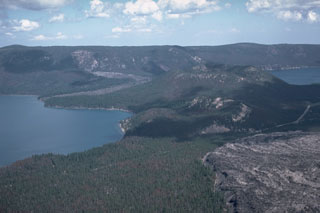 A major eruption about 6,400 years ago produced the large Central Pumice Cone in the center of Newberry caldera, a pumice ring, and obsidian lava flows. The Interlake obsidian flow (on the far side of the left-hand lake, Paulina) originated from a vent on the north caldera wall and flowed onto the caldera floor and divided around Central Pumice Cone. The west lobe (seen here) flowed into Paulina Lake, while the east lobe flowed behind Central Pumice Cone into East Lake. The Game Hut obsidian flow was also erupted at this time.
A major eruption about 6,400 years ago produced the large Central Pumice Cone in the center of Newberry caldera, a pumice ring, and obsidian lava flows. The Interlake obsidian flow (on the far side of the left-hand lake, Paulina) originated from a vent on the north caldera wall and flowed onto the caldera floor and divided around Central Pumice Cone. The west lobe (seen here) flowed into Paulina Lake, while the east lobe flowed behind Central Pumice Cone into East Lake. The Game Hut obsidian flow was also erupted at this time.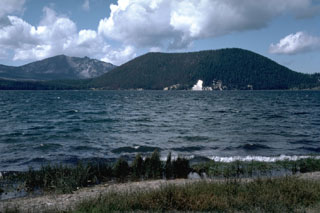 The Central Pumice Cone at the right formed during a major rhyolitic eruption about 6,400 years ago. Many other vents on the north and south caldera walls and the caldera floor were also active at this time, producing pumice rings and obsidian flows. Paulina Peak forms the high point on the south caldera rim at the left.
The Central Pumice Cone at the right formed during a major rhyolitic eruption about 6,400 years ago. Many other vents on the north and south caldera walls and the caldera floor were also active at this time, producing pumice rings and obsidian flows. Paulina Peak forms the high point on the south caldera rim at the left.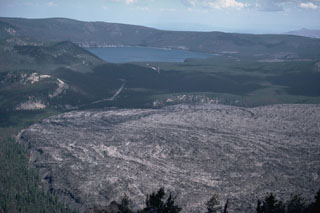 The Big Obsidian Flow lava flow in the foreground covers about 2.6 km2 of the floor of Newberry caldera and was emplaced about 1,300 years ago. The eruption occurred at a vent at the base of the southern caldera wall, out of view to the right.
The Big Obsidian Flow lava flow in the foreground covers about 2.6 km2 of the floor of Newberry caldera and was emplaced about 1,300 years ago. The eruption occurred at a vent at the base of the southern caldera wall, out of view to the right.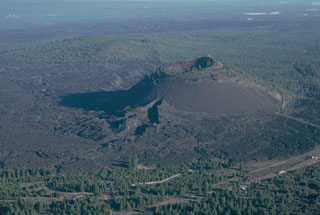 Lava Butte is a scoria cone on the NW flank of Newberry volcano at the end of fissure system that extended from the caldera rim about 7,000 years ago. Following construction of the cone, the SW flank fissure at the base of the cone (in the foreground) fed a voluminous lava flow that traveled to the north and changed the course of the Deschutes River.
Lava Butte is a scoria cone on the NW flank of Newberry volcano at the end of fissure system that extended from the caldera rim about 7,000 years ago. Following construction of the cone, the SW flank fissure at the base of the cone (in the foreground) fed a voluminous lava flow that traveled to the north and changed the course of the Deschutes River.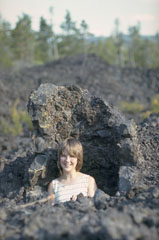 The Lava Cast Forest lava flow on the NW flank of Newberry formed about 7,000 years ago. It contains hollow tree molds that stand above the surface of the flow. These features formed when flowing lava chilled around standing tree trunks that subsequently burned from the heat of the lava. Horizontal tree molds formed around trees that had either previously fallen or were toppled by the advancing lava flow.
The Lava Cast Forest lava flow on the NW flank of Newberry formed about 7,000 years ago. It contains hollow tree molds that stand above the surface of the flow. These features formed when flowing lava chilled around standing tree trunks that subsequently burned from the heat of the lava. Horizontal tree molds formed around trees that had either previously fallen or were toppled by the advancing lava flow. 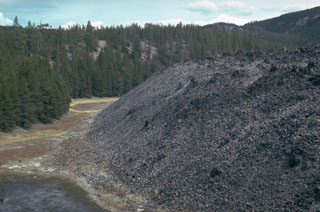 This is the NE margin of the Big Obsidian Flow, which erupted from a vent near the Newberry southern caldera wall about 1,300 years ago into this crater, whose forested rim is seen in the background.
This is the NE margin of the Big Obsidian Flow, which erupted from a vent near the Newberry southern caldera wall about 1,300 years ago into this crater, whose forested rim is seen in the background. 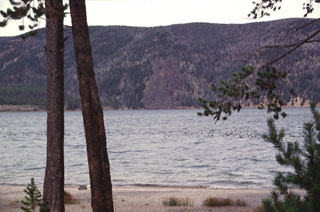 The East Lake Fissure (center) cutting through the northern rim of Newberry caldera is part of the northwest rift zone. The basaltic lava flow (the unvegetated area in the center of the photo) can be seen descending into the NE corner of East Lake.
The East Lake Fissure (center) cutting through the northern rim of Newberry caldera is part of the northwest rift zone. The basaltic lava flow (the unvegetated area in the center of the photo) can be seen descending into the NE corner of East Lake. 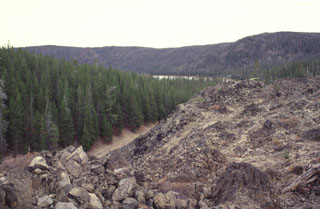 The East Lake obsidian flows and associated pumice deposits erupted from fissures parallel to the inner caldera wall. The westernmost of the two obsidian flows immediately south of East Lake is seen here. It traveled to the north towards East Lake, part of which can be seen beyond the forested area in the center of the photo, below the eastern caldera wall.
The East Lake obsidian flows and associated pumice deposits erupted from fissures parallel to the inner caldera wall. The westernmost of the two obsidian flows immediately south of East Lake is seen here. It traveled to the north towards East Lake, part of which can be seen beyond the forested area in the center of the photo, below the eastern caldera wall. 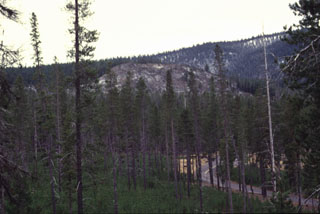 The easternmost of the two East Lake obsidian flows forms the sparsely vegetated area in the center of the photo near the SE shore of East Lake. This rhyolitic flow, another one to the west, and associated pumice deposits erupted from fissures parallel to the inner caldera wall.
The easternmost of the two East Lake obsidian flows forms the sparsely vegetated area in the center of the photo near the SE shore of East Lake. This rhyolitic flow, another one to the west, and associated pumice deposits erupted from fissures parallel to the inner caldera wall. 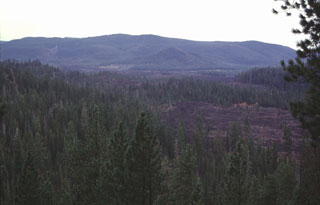 Three lava flows that erupted from fissure vents on the NW rift zone of Newberry volcano about 7,000 years ago can be seen in this photo. The Forest Road Flow in the foreground was one of the smallest. Behind it are the Lava Cast Forest and Lava Cascades flows. The latter traveled about 8 km from its vent. The northern rim of Newberry caldera forms the ridge on the horizon.
Three lava flows that erupted from fissure vents on the NW rift zone of Newberry volcano about 7,000 years ago can be seen in this photo. The Forest Road Flow in the foreground was one of the smallest. Behind it are the Lava Cast Forest and Lava Cascades flows. The latter traveled about 8 km from its vent. The northern rim of Newberry caldera forms the ridge on the horizon.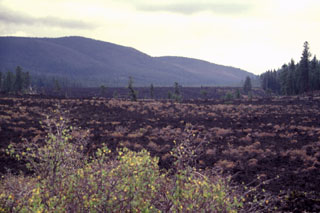 The Lava Cascade lava flow erupted from the Newberry NW rift zone about 7,000 years ago and traveled about 8 km NW from its vent. The forested area to the far right is one of three large kipukas composed of older lavas that were surrounded by the flow. The flow in the foreground, called the Lava Cast Forest flow, originated from another fissure at about the same time. The NW rim of Newberry caldera rises in the distance.
The Lava Cascade lava flow erupted from the Newberry NW rift zone about 7,000 years ago and traveled about 8 km NW from its vent. The forested area to the far right is one of three large kipukas composed of older lavas that were surrounded by the flow. The flow in the foreground, called the Lava Cast Forest flow, originated from another fissure at about the same time. The NW rim of Newberry caldera rises in the distance.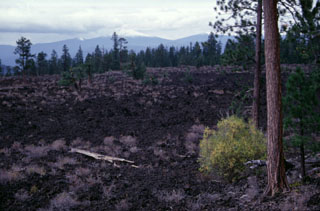 The Lava Cast Forest Flow was one of several lava flows erupted from the upper NW rift zone of Newberry volcano about 7,000 years ago. The flow is named for its abundant casts of trees that formed when lava chilled and cooled around standing or fallen tree trunks.
The Lava Cast Forest Flow was one of several lava flows erupted from the upper NW rift zone of Newberry volcano about 7,000 years ago. The flow is named for its abundant casts of trees that formed when lava chilled and cooled around standing or fallen tree trunks.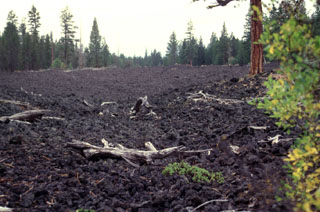 The small Forest Road lava flow that was erupted from fissures on the central NW rift zone of Newberry. This lava flow, one of the smallest from the NW rift zone of Newberry volcano, originated from a fissure vent immediately NW of the Lava Cast Forest flow.
The small Forest Road lava flow that was erupted from fissures on the central NW rift zone of Newberry. This lava flow, one of the smallest from the NW rift zone of Newberry volcano, originated from a fissure vent immediately NW of the Lava Cast Forest flow.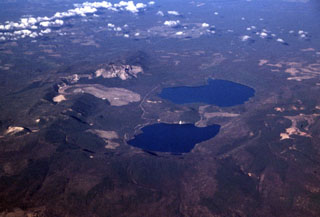 Newberry caldera is one of the largest volcanoes in the conterminous United States, covering an area of about 3,200 km2. Two lakes, Paulina Lake (top) and East Lake (bottom) partially fill the 6.5 x 8 km wide caldera, which formed following the eruption of major pyroclastic flows during the Pleistocene. Subsequent eruptions have taken place from vents within the caldera, near its rim, and from fissures on its flanks. The light-colored lobate lava flow south (left) of Paulina Lake is one of several obsidian flows erupted during the Holocene.
Newberry caldera is one of the largest volcanoes in the conterminous United States, covering an area of about 3,200 km2. Two lakes, Paulina Lake (top) and East Lake (bottom) partially fill the 6.5 x 8 km wide caldera, which formed following the eruption of major pyroclastic flows during the Pleistocene. Subsequent eruptions have taken place from vents within the caldera, near its rim, and from fissures on its flanks. The light-colored lobate lava flow south (left) of Paulina Lake is one of several obsidian flows erupted during the Holocene.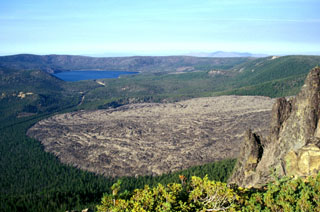 The Big Obsidian Flow covers 2.6 km2 of the floor of Newberry caldera and was emplaced about 1,300 years ago. The eruption began from a vent at the base of the southern caldera wall with a large pumice fall deposit followed by a pyroclastic flow that entered Paulina Lake, and finally with emplacement of the obsidian flow. East Lake lies in the background in this view from the southern caldera rim.
The Big Obsidian Flow covers 2.6 km2 of the floor of Newberry caldera and was emplaced about 1,300 years ago. The eruption began from a vent at the base of the southern caldera wall with a large pumice fall deposit followed by a pyroclastic flow that entered Paulina Lake, and finally with emplacement of the obsidian flow. East Lake lies in the background in this view from the southern caldera rim. Newberry volcano, one of the largest Quaternary volcanoes in the conterminous United States, lies 60 km E of the crest of the Cascade Range in central Oregon. The shield volcano contains a 5 x 7 km caldera with two lakes, Paulina Lake (left) and East Lake (right). Newberry has been active during the Holocene at vents within the caldera that have produced pumice cones and obsidian lava flows (like Obsidian flow to the lower right), and outside the caldera forming scoria cones on its broad flanks.
Newberry volcano, one of the largest Quaternary volcanoes in the conterminous United States, lies 60 km E of the crest of the Cascade Range in central Oregon. The shield volcano contains a 5 x 7 km caldera with two lakes, Paulina Lake (left) and East Lake (right). Newberry has been active during the Holocene at vents within the caldera that have produced pumice cones and obsidian lava flows (like Obsidian flow to the lower right), and outside the caldera forming scoria cones on its broad flanks.The following 30 samples associated with this volcano can be found in the Smithsonian's NMNH Department of Mineral Sciences collections, and may be availble for research (contact the Rock and Ore Collections Manager). Catalog number links will open a window with more information.
| Catalog Number | Sample Description | Lava Source | Collection Date |
|---|---|---|---|
| NMNH 117465-1 | Obsidian | -- | -- |
| NMNH 117465-10 | Pumice | Lost Lake Obsidian Flow | -- |
| NMNH 117465-11 | Obsidian | Lost Lake Obsidian Flow | -- |
| NMNH 117465-12 | Obsidian | Lost Lake Obsidian Flow | -- |
| NMNH 117465-13 | Obsidian | Big Obsidian Flow | -- |
| NMNH 117465-14 | Obsidian | Lost Lake Obsidian Flow | -- |
| NMNH 117465-15 | Obsidian | Lost Lake Obsidian Flow | -- |
| NMNH 117465-16 | Volcanic Bomb | Lost Lake Obsidian Flow | -- |
| NMNH 117465-17 | Pumice | Lost Lake Obsidian Flow | -- |
| NMNH 117465-18 | Pumice | Lost Lake Obsidian Flow | -- |
| NMNH 117465-19 | Pumice | Lost Lake Obsidian Flow | -- |
| NMNH 117465-2 | Obsidian | -- | -- |
| NMNH 117465-20 | Obsidian | -- | -- |
| NMNH 117465-21 | Obsidian | -- | -- |
| NMNH 117465-22 | Obsidian | -- | -- |
| NMNH 117465-23 | Pumice | -- | -- |
| NMNH 117465-24 | Pumice | -- | -- |
| NMNH 117465-25 | Pumice | Lost Lake Obsidian Flow | -- |
| NMNH 117465-26 | Pumice | Lost Lake Obsidian Flow | -- |
| NMNH 117465-27 | Glass | -- | -- |
| NMNH 117465-28 | Pumice | -- | -- |
| NMNH 117465-29 | Glass | -- | -- |
| NMNH 117465-3 | Pumice | -- | -- |
| NMNH 117465-30 | Pumice | -- | -- |
| NMNH 117465-4 | Pumice | -- | -- |
| NMNH 117465-5 | Pumice | -- | -- |
| NMNH 117465-6 | Pumice | -- | -- |
| NMNH 117465-7 | Pumice | -- | -- |
| NMNH 117465-8 | Obsidian | -- | -- |
| NMNH 117465-9 | Obsidian | -- | -- |
| Copernicus Browser | The Copernicus Browser replaced the Sentinel Hub Playground browser in 2023, to provide access to Earth observation archives from the Copernicus Data Space Ecosystem, the main distribution platform for data from the EU Copernicus missions. |
| MIROVA | Middle InfraRed Observation of Volcanic Activity (MIROVA) is a near real time volcanic hot-spot detection system based on the analysis of MODIS (Moderate Resolution Imaging Spectroradiometer) data. In particular, MIROVA uses the Middle InfraRed Radiation (MIR), measured over target volcanoes, in order to detect, locate and measure the heat radiation sourced from volcanic activity. |
| MODVOLC Thermal Alerts | Using infrared satellite Moderate Resolution Imaging Spectroradiometer (MODIS) data, scientists at the Hawai'i Institute of Geophysics and Planetology, University of Hawai'i, developed an automated system called MODVOLC to map thermal hot-spots in near real time. For each MODIS image, the algorithm automatically scans each 1 km pixel within it to check for high-temperature hot-spots. When one is found the date, time, location, and intensity are recorded. MODIS looks at every square km of the Earth every 48 hours, once during the day and once during the night, and the presence of two MODIS sensors in space allows at least four hot-spot observations every two days. Each day updated global maps are compiled to display the locations of all hot spots detected in the previous 24 hours. There is a drop-down list with volcano names which allow users to 'zoom-in' and examine the distribution of hot-spots at a variety of spatial scales. |
|
WOVOdat
Single Volcano View Temporal Evolution of Unrest Side by Side Volcanoes |
WOVOdat is a database of volcanic unrest; instrumentally and visually recorded changes in seismicity, ground deformation, gas emission, and other parameters from their normal baselines. It is sponsored by the World Organization of Volcano Observatories (WOVO) and presently hosted at the Earth Observatory of Singapore.
GVMID Data on Volcano Monitoring Infrastructure The Global Volcano Monitoring Infrastructure Database GVMID, is aimed at documenting and improving capabilities of volcano monitoring from the ground and space. GVMID should provide a snapshot and baseline view of the techniques and instrumentation that are in place at various volcanoes, which can be use by volcano observatories as reference to setup new monitoring system or improving networks at a specific volcano. These data will allow identification of what monitoring gaps exist, which can be then targeted by remote sensing infrastructure and future instrument deployments. |
| Volcanic Hazard Maps | The IAVCEI Commission on Volcanic Hazards and Risk has a Volcanic Hazard Maps database designed to serve as a resource for hazard mappers (or other interested parties) to explore how common issues in hazard map development have been addressed at different volcanoes, in different countries, for different hazards, and for different intended audiences. In addition to the comprehensive, searchable Volcanic Hazard Maps Database, this website contains information about diversity of volcanic hazard maps, illustrated using examples from the database. This site is for educational purposes related to volcanic hazard maps. Hazard maps found on this website should not be used for emergency purposes. For the most recent, official hazard map for a particular volcano, please seek out the proper institutional authorities on the matter. |
| IRIS seismic stations/networks | Incorporated Research Institutions for Seismology (IRIS) Data Services map showing the location of seismic stations from all available networks (permanent or temporary) within a radius of 0.18° (about 20 km at mid-latitudes) from the given location of Newberry. Users can customize a variety of filters and options in the left panel. Note that if there are no stations are known the map will default to show the entire world with a "No data matched request" error notice. |
| UNAVCO GPS/GNSS stations | Geodetic Data Services map from UNAVCO showing the location of GPS/GNSS stations from all available networks (permanent or temporary) within a radius of 20 km from the given location of Newberry. Users can customize the data search based on station or network names, location, and time window. Requires Adobe Flash Player. |
| DECADE Data | The DECADE portal, still in the developmental stage, serves as an example of the proposed interoperability between The Smithsonian Institution's Global Volcanism Program, the Mapping Gas Emissions (MaGa) Database, and the EarthChem Geochemical Portal. The Deep Earth Carbon Degassing (DECADE) initiative seeks to use new and established technologies to determine accurate global fluxes of volcanic CO2 to the atmosphere, but installing CO2 monitoring networks on 20 of the world's 150 most actively degassing volcanoes. The group uses related laboratory-based studies (direct gas sampling and analysis, melt inclusions) to provide new data for direct degassing of deep earth carbon to the atmosphere. |
| Large Eruptions of Newberry | Information about large Quaternary eruptions (VEI >= 4) is cataloged in the Large Magnitude Explosive Volcanic Eruptions (LaMEVE) database of the Volcano Global Risk Identification and Analysis Project (VOGRIPA). |
| EarthChem | EarthChem develops and maintains databases, software, and services that support the preservation, discovery, access and analysis of geochemical data, and facilitate their integration with the broad array of other available earth science parameters. EarthChem is operated by a joint team of disciplinary scientists, data scientists, data managers and information technology developers who are part of the NSF-funded data facility Integrated Earth Data Applications (IEDA). IEDA is a collaborative effort of EarthChem and the Marine Geoscience Data System (MGDS). |